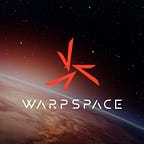Japan’s Growing Presence in Lunar Exploration! Toyota’s LUNAR CRUISER and Two Japanese Astronauts to Land on the Moon. 【Warpspace CSO Talks About Space Symposium 2024 Part Ⅲ】
In this series, Warpspace CSO Hirokazu Mori introduces the news presented at the Space Symposium 2024, one of the world’s largest satellite industry conferences, held in Colorado Springs, U.S.A., April 8–11, 2024, and the topics that particularly caught his attention.
In this third part of the article, we will discuss in detail “Toyota’s Pressurized Lunar Rover and Two Japanese Astronauts to the Moon”.
Toyota and JAXA’s Pressurized Lunar Rover Goes to the Moon’s Surface
On April 10, 2024 (Japan Standard Time), Japan and the United States signed an “Arrangement for the Exploration of the Lunar Surface by a Pressurized Rover” in connection with the international space exploration program “Artemis Project”. (*1)
This pressurized rover is the “LUNAR CRUISER,” which is being developed jointly by Toyota and JAXA and will be used as a means of transportation for astronauts during lunar exploration.
“The significance of Japan playing an important role in the Artemis mission is great,” said Mori. We have seen Japan’s fundamental strength.
Reference
(*1 [JAXA] NASA and Japanese Government sign the Implementing Arrangement concerning Lunar Surface Exploration using the Pressurized Rover)
The LUNAR CRUISER has an enclosed space called a “pressurized cabin” in which the air pressure inside the vehicle is adjusted to create an environment similar to that on the ground. Therefore, even in the harsh environment of the lunar surface, the LUNAR CRUISER will be a vehicle that combines comfort and safety, without the need to wear extra-vehicular activity (EVA) suits like conventional lunar rovers (*2).
The development of the LUNAR CRUISER has been undertaken not only by JAXA and Toyota but also by Team Japan, with Mitsubishi Heavy Industries in charge of the portion of the system and Bridgestone in charge of the metal tires. The LUNAR CRUISER, which is still under development with that structure, is planned to be in operation for 10 years starting with the Artemis 7 scheduled for 2031 (*3).
In addition, Fumiya Tsutsui, who oversees JAXA’s technical areas, said,
“The crewed pressurized rover can be used by two astronauts for exploration while traveling over 30 days. When not crewed, the rover can run uncrewed and perform a variety of activities. It will play a central role in the exploration activities of the Artemis program.”
References
(*2 [TOYOTA] JAXA and Toyota Reach Agreement on Consideration Toward International Space Exploration)(*3 [TOYOTA Times]Team Japan Sets Sights on Space! Update on LUNAR CRUISER Development)
The Artemis program will include the exploration of ice (water ice) believed to be buried in the permanent shadow of the Lunar South Pole, and there are great expectations for the
LUNAR CRUISER, which will combine the functions of a “moving lunar base”. In exchange for providing the crewed pressurized rover and bearing the development costs, Japan will send two Japanese astronauts to land on the Moon.
Japan-U.S. Agreement on “Two Japanese Astronauts to Land on the Moon
At a summit meeting on April 11, 2024 (Japan Standard Time), President Biden said,
“I was one of the people in the United States who was excited about the grand challenge of space. I welcome the first non-U.S. astronaut to land on the Moon under the Artemis program.
He announced and congratulated the commitment of Japanese astronauts to land on the Moon (*5).
References
(*4【SPACE.com】Japanese astronauts will join NASA moon landings in return for lunar rover)(*5【SPACEPOLICYONLINE】 BIDEN AND KISHIDA: FIRST NON-US ASTRONAUT ON THE MOON WILL BE JAPANESE)
From 1969 to 1972, 12 humans landed on the Moon as part of NASA’s Apollo program, all of them Americans. The Artemis program, which will be the first crewed lunar landing in about 50 years, aims to conduct a test flight with a spacecraft carrying astronauts orbiting the Moon as early as the latter half of 2025 (Artemis 2), followed by a mission in September 2026 (Artemis 3), when astronauts will land on the lunar surface. (*6).
Reference
(*6【SPACENEWS】 NASA delays Artemis 2 and 3 missions)
The first Japanese astronaut to land on the Moon under this plan is expected to be Artemis 4 in 2028. The second Japanese astronaut is scheduled to land on the Moon in 2031 for Artemis 7 and is expected to be the first to fly the LUNAR CRUISER.
In addition, astronauts will continue to explore the Moon after 2026, with plans for extended stays on the lunar surface and future crewed exploration of Mars.
Reference
(*7【NASA】 Gateway)
According to JAXA, no decision has been made on how to select the first Japanese astronaut to land on the Moon at this time.
The five Japanese astronauts currently working for JAXA are Satoshi Furukawa, Akihiko Hoshide, Yui Kimiya, Takuya Onishi, and Norishige Kanai. All of them have experienced ISS long-duration stays of more than 100 days, contributing to Japan’s space development.
In addition, two new astronaut candidates, Makoto Suwa, and Ayu Yoneda, were selected in 2023 and are expected to participate in future lunar missions.
“Because of the mandatory retirement at the age of 60, who is selected will probably depend on the speed of development of SpaceX, which will be the first to make a crewed landing on the Moon,” Mori said.
The first crewed lunar landing is an achievement that symbolizes the spirit of exploration and technological progress of humankind, and Japan will be the second country, after the United States, to make history in the world’s space history. Who will be the first Japanese person to land on the Moon? Stay tuned!
(Writer: Natsumi Kawaguchi)
